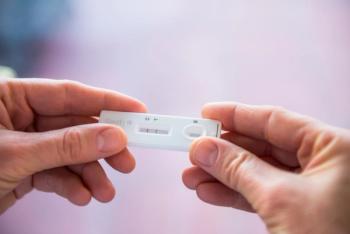
- June 2023
- Volume 40
- Issue 5
Grappling with eating disorders among elite student athletes
Patients who are highly competitive in sports sometimes drastically restrict food intake in an attempt to outperform their peers.
The physical and mental health of elite student athletes can suffer due to the significant pressure that this population often experiences when trying to stay competitive in their chosen sports. Unhealthy nutritional habits can quickly become the norm and lead to a downward spiraling of their general health. Reestablishing and maintaining a balanced, nutritious diet may require a multidisciplinary approach to help elite student athletes get back on the right track.
The stress that this population endures when trying to maintain a certain weight class in their chosen sports, such as wrestling, gymnastics, or track and field, can lead to avoidant/restrictive food intake disorders, bulimia nervosa, and anorexia nervosa. Appropriate counseling from medical health care professionals and the involvement of coaches, athletic trainers, family, and friends can be instrumental in helping this patient population overcome their eating disorders and set them on a healthier path.
“These student athletes may experience a heightened pressure to perform, which can often lead to the incorporation of unhealthy eating habits. They might overconsume particular types of foods that are high in protein or have an overreliance on particular food supplements that can have harmful health side effects or create an imbalance of nutrients. They may not hydrate enough or try to reduce the amount that they hydrate, or just skip meals altogether, which can have both negative physical and mental repercussions,” noted Emily Jennifer Aron, MD, department of psychiatry, MedStar Georgetown University Hospital, Washington, DC.
The subclinical symptoms of eating disorders can include skipping meals, exercising obsessively, vomiting, and using laxatives and diuretics. A restrictive diet and skipping meals altogether can lead to a reduction in cognitive functioning, Aron said, and have a negative impact on the athlete’s perception of their body and body image.
In industrialized countries, eating disorders are the third most common chronic disease in female adolescents. In Western countries, the rates of anorexia and bulimia are 0.3 percent and 1 percent, respectively. A recent study found that the influence of mass media regarding ideal body image is associated with a greater probability of adolescents presenting with body dissatisfaction. This increase in body dissatisfaction is further associated with an increased risk of developing eating disorders in adolescents, with females being more affected than their male counterparts.1
Rates of eating disorders appear to be significantly high in US collegiate athletes, with up to 84% of them having reported engaging in maladaptive eating and weight control behaviors, including binge eating, excessive exercise, strict dieting, fasting, self-induced vomiting, and the use of weight loss supplements.2
“The prevalence rate of eating disorders in elite student athletes is varied; however, it is certainly higher than that seen in the general population. I believe it is harder to recognize eating disorders when you are part of and deeply invested in a specific culture because they are normalized by the group you are in,” Aron said.
During the COVID-19 pandemic, when telehealth models were commonly being used, clinicians found it challenging to detect eating disorders in their patients because they only viewed the faces of patients. Clinicians therefore needed to rely on the openness of their patients regarding their eating habits and their overall satisfaction or concern about their body images.
Pediatricians and other health care providers such as school nurses, as well as invested athletic trainers and coaches, also could recognize the student athlete’s potential eating disorders. According to Aron, this is the area that clinicians and concerned individuals should focus on and understand to try to help the student athlete.
“Oftentimes, the onus of addressing eating disorders in elite student athletes falls upon first-line health care providers such as pediatricians. In those student athletes who may have an eating disorder, it is not only paramount that pediatricians see them more often, but also ask open-ended questions in a nonjudgmental way during the consult. Pediatricians should cautiously inquire about what their student athlete patients like to eat, if they’ve ever tried to lose weight, as well as how the student athlete feels about their general body image,” Aron said.
Pediatricians can also cleverly approach this sensitive topic indirectly by asking the student athlete if their family, friends, or fellow students have had any eating disorders or difficulties regarding weight loss or general dissatisfaction with their body image. According to Aron, this indirect way of tapping into the topic can often help open the door for the student athlete to be more candid regarding their own potential eating disorder struggles.
“The ubiquitous dissemination of information regarding healthy nutritional habits can be instrumental in helping student athletes understand the long-term consequences of disordered eating and the harmful effects such bad habits can have on the body, especially as an athlete. Here, social media can be a powerful tool and those pediatricians with social media accounts can easily disseminate helpful nutritional information to their patients. This can help move the message beyond the one-on-one encounter in the traditional patient consult,” Aron said.
Aron also notes that only recently have elite athletes begun to come forward and openly speak of the great mental challenges they face, such as anxiety and depression, although Aron notes it is important to remember that student athletes can struggle with depression and anxiety separate from having an eating disorder, because they do not always go hand in hand.
Appropriately addressing the mosaic of eating disorders in student athletes is a comprehensive treatment that typically requires a multidisciplinary approach, including input from a nutritionist, dietician, pediatrician, and, sometimes, a psychiatrist or therapist. According to Aron, medical professionals may give well-meant advice to the patient and dictate what’s right or wrong, an approach that can quickly shut down the conversation with troubled patients seeking help.
“During the consult, it is very important to not dictate what the student athlete should or should not do so that they feel comfortable enough to be able to openly discuss their feelings about their body and the eating struggles they may have. Physicians need to remain open, listen, and employ motivational interviewing skills to better reach the student athlete and have them open up about their problems,” Aron said.
Many individuals with eating disorders already know that what they are doing is detrimental to their health, Aron said, but they nevertheless will still want to continue with their poor eating habits. Exploring that mindset can be very useful in helping them come to a decision to get professional help. In addition, physicians and the concerned network of family, friends, coaches, and athletic trainers should always keep an eye out for the associated warning signs of eating disorders, which can include weight loss and excessive exercise routines. The pediatrician could ask family members to reach out to this extended network to share their concerns, so that the athlete’s larger circle can also keep a watchful eye on them.
“It is important to keep eating disorders in mind when caring for elite student athletes because poor nutritional habits are not uncommon in this population. Physicians should remember to ask the question, because if they do not actively inquire about eating disorders, their patients may not be so forthcoming with information regarding their eating habits and the struggles they may have regarding appropriate healthy food intake,” Aron said.
References:
1. Uchôa FNM, Uchôa NM, da Costa Daniele TM, et al. Influence of the mass media and body dissatisfaction on the risk in adolescents of developing eating disorders. Int J Environ Res Public Health. 2019;16(9):1508. doi:10.3390/ijerph16091508
2. Power K, Kovacs S, Butcher-Poffley L, Wu J, Sarwer D. Disordered eating and compulsive exercise in collegiate athletes: applications for sport and research. The Sport Journal. 2020;23(7):41. https://www.cabdirect.org/globalhealth/abstract/20203429752
Articles in this issue
over 2 years ago
Strict vegan and vegetarian diets, a challenge for providersover 2 years ago
Keeping patients safe from summertime illnessesover 2 years ago
A better acne treatment may be comingover 2 years ago
Neonate experiences coffee ground emesisover 2 years ago
Pediatricians must play a role in early plant-based dietsover 2 years ago
Prevention strategies are key to child safety this summerover 2 years ago
How can we decrease distress during facial laceration repair?Newsletter
Access practical, evidence-based guidance to support better care for our youngest patients. Join our email list for the latest clinical updates.














